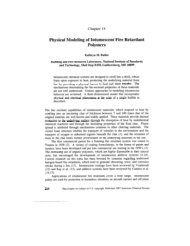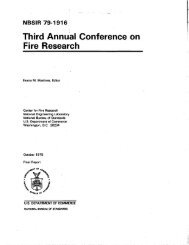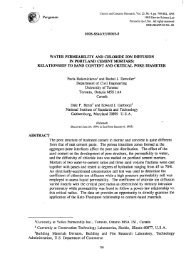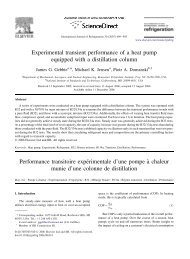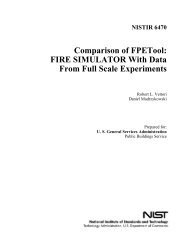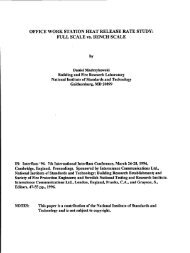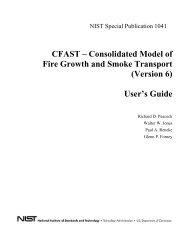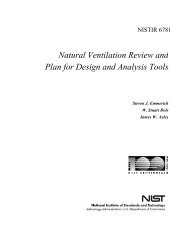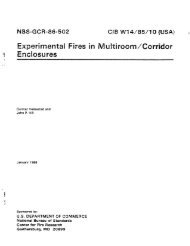Study of Technology for Detecting Pre-Ignition Conditions of ... - NIST
Study of Technology for Detecting Pre-Ignition Conditions of ... - NIST
Study of Technology for Detecting Pre-Ignition Conditions of ... - NIST
You also want an ePaper? Increase the reach of your titles
YUMPU automatically turns print PDFs into web optimized ePapers that Google loves.
.<br />
CPSC-IAG95-1145<br />
amount <strong>of</strong> room-temperature com oil was measured and poured into the pan. A stopwatch was<br />
started as the burner was turned on at the highest setting. The temperature <strong>of</strong> the com oil was<br />
recorded every 30 or 60 seconds. Upon ignitio~ a lid was placed on the pan to snuff out the<br />
fire, and a C02 extinguisher was also available to assist with extinguishment.<br />
Table 1 summarizes the conditions and results <strong>of</strong> the parametric tests, each <strong>of</strong> which was<br />
per<strong>for</strong>med once. The test plan evolved as greater understanding <strong>of</strong> the parameter interactions was<br />
gained. The first five tests were per<strong>for</strong>med on the inexpensive gas range with oil. The amount<br />
<strong>of</strong> oil and pan type were varied. Oil cooked in stainless steel ignited in each case with the<br />
greater amount <strong>of</strong> oil requiring more time. The combination <strong>of</strong> the average power output <strong>of</strong> the<br />
range and the heat transfer characteristics <strong>of</strong> the aluminum pans did not enable the oil to reach<br />
ignition temperatures. To aid in the selection <strong>of</strong> a carbohydrate test food, a sixth test was<br />
per<strong>for</strong>med on the open-coil element electric range with baked beans. Temperatures inside the pan<br />
reached over 530 ‘C, but ignition did not occur. A seventh test was per<strong>for</strong>med on the same<br />
electric range with corn oil in a non-stick aluminum frying pan. This test was primarily used to<br />
determine whether a fke could occur when the food was contained in an aluminum pan. The<br />
temperature was not measured, but the oil did eventually ignite.<br />
The results from these experiments were helpfil in deciding what materials to use in the<br />
instrumented tests. Ah.uninum was ruled out as a pan material because <strong>of</strong> the inability <strong>of</strong> the<br />
typical gas range to ignite com oil. Stainless steel provided both ignition and short test duration<br />
which was desirable. The difference in oil volume <strong>for</strong> the tests conducted with stainless steel<br />
affected the time <strong>of</strong> ignition, but did not greatly affect the ignition temperature. Similarly, the<br />
temperature histories fix the tests using two types <strong>of</strong> aluminum pans and two amounts <strong>of</strong> oil were<br />
different, but the final steady temperatures were comparable. Since the impact on test duration<br />
was not large and find temperatures were similar, pan sizes and fmd amounts were selected<br />
using reasonable cooking practices. The lack <strong>of</strong> ignition <strong>of</strong> the baked beans, although they were<br />
heated in an aluminum pan, discouraged the use <strong>of</strong> this food in the fully-instrumented tests since<br />
the ability to ignite ww doubtfid.<br />
2.1.4 Instrumented-Test Parameters<br />
Table 2 summarizes the food types, amounts, and the pans selected <strong>for</strong> testing. The<br />
rationale behind the selection <strong>of</strong> vegetable oil was that preheating oil in a pan be<strong>for</strong>e Cooking a<br />
solid food item inside is a common practice and is a known circumstance leading to many<br />
cooking fires. Also, oils vaporize more readily than solid finds and thus cause more intense<br />
fires. Soybean oil wa$ the particular oil chosen because it holds 75 YO to 80 % <strong>of</strong> the cooking<br />
oil market.3 Most commonly used vegetable oils are processed in order to have less than 2 YO<br />
free fatty acid content. This translates into similar smoke (140 ‘C -230 “C), flash (275 ‘C -<br />
335 “C), and fire (350 ‘C -365 “C) points. 4 The pan size was selected so that the 20 cm (8 in)<br />
burner &ea would most closely match the area <strong>of</strong> the bottom <strong>of</strong> the pan. The volume <strong>of</strong> oil was<br />
chosen to provide a reasonable depth <strong>for</strong> f~ing in the pan.<br />
Bacon was chosen as the second food. The rationale behind the selection <strong>of</strong> bacon was<br />
that animal fats and greases are other commonly cooked foods, and grease and oil fires seem to<br />
be the most prevalent cooking fires. Another scenario that was considered was the frying <strong>of</strong> lard<br />
5



